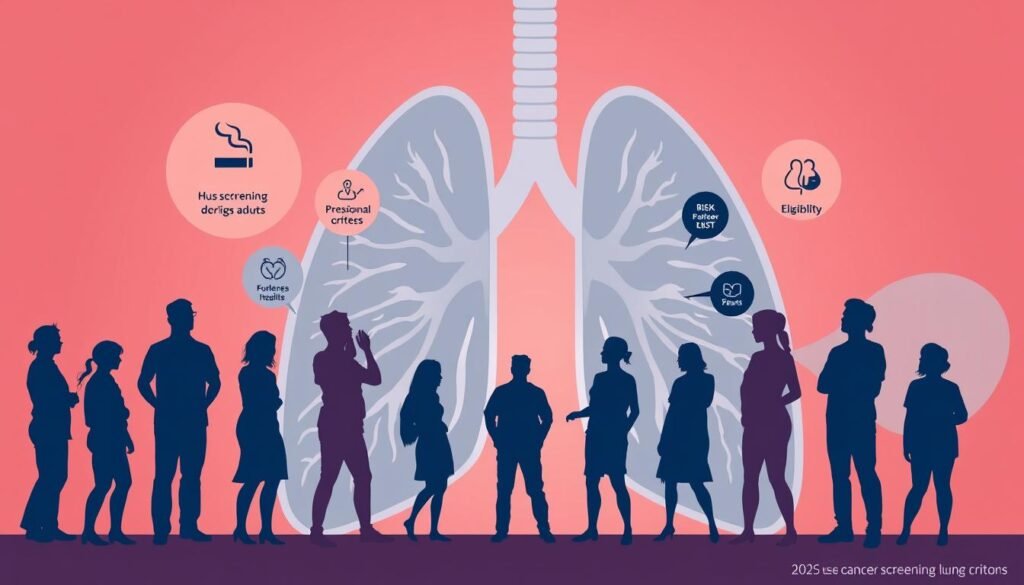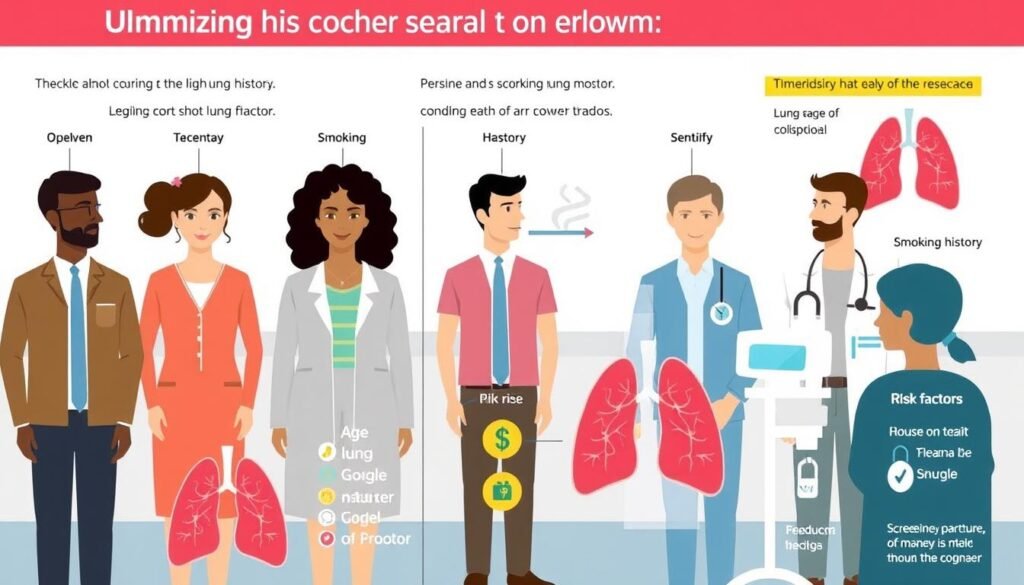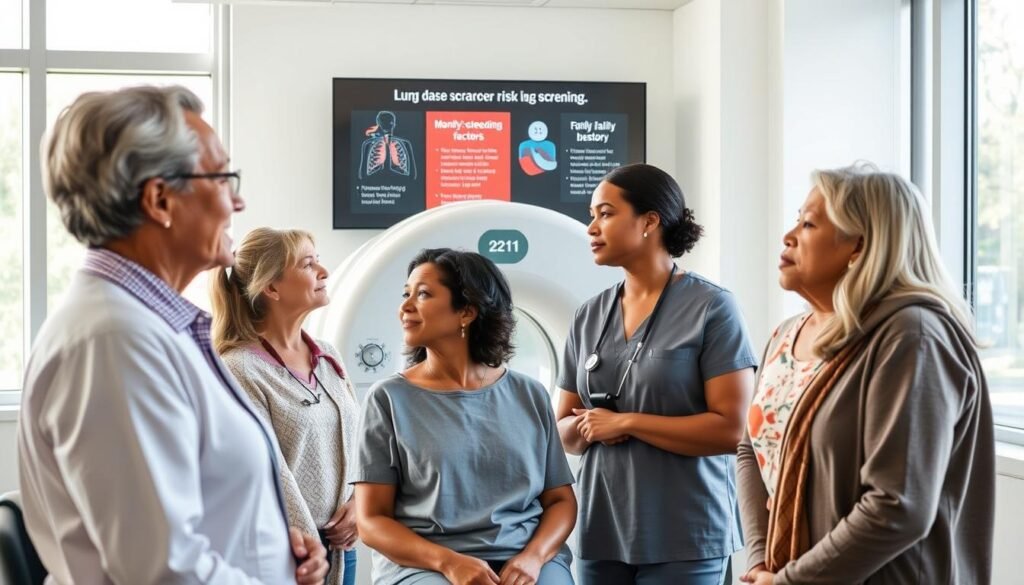Every year, about 234,580 individuals are told they have lung cancer in the United States. This makes it the top cause of cancer deaths for both genders. Many people don’t know who needs to be screened for lung cancer. The most recent lung cancer screening guidelines highlight how crucial early detection is. It’s especially important for those at high risk, using things like low-dose CT scans.
It’s crucial to know if you’re eligible for lung cancer screening. Finding lung cancer early can greatly increase the chances of successful treatment. The U.S. Preventive Services Task Force advises screening for those 50 to 80 years old, especially if they’ve smoked a lot. Knowing these guidelines can help in battling this lethal illness.
Key Takeaways
- Over 125,000 people in the U.S. die from lung cancer each year.
- Screening is crucial for individuals aged 50 to 80 with a significant smoking history.
- The latest guidelines aim to reduce disparities in lung cancer screening.
- Early detection through low-dose CT scans can lead to better health outcomes.
- Smoking cessation significantly lowers lung cancer risk.
- Annual screenings may identify other health issues beyond lung cancer.
Understanding Lung Cancer Risk Factors
Knowing what increases lung cancer risk is key to preventing it. Smoking is a huge risk factor. It causes about 80% of lung cancer deaths. If you’ve smoked, your risk of lung cancer goes way up. But, quitting smoking can greatly improve your health. It lowers your chances of getting lung cancer. You can learn more about this at this link.
Importance of Smoking History
Smoking and lung cancer are closely linked. Years of smoking can lead to cancer. Those with a 20 pack-year history are especially at risk. A pack-year means smoking one pack a day for a year. It’s important for them to think about getting screened.
Impact of Age on Risk
Age also affects lung cancer risk. Most people are diagnosed around age 70. Risk goes up with age, especially if you’ve smoked a lot. People between 50 to 80 should get screened every year. This helps catch cancer early. Knowing how age impacts risk helps in managing health better.
Who Should Get Screened for Lung Cancer?
Lung cancer is the top cancer killer in the United States for everyone. Knowing who should get screened is key. It helps find people at risk early, which can save lives.
Criteria for Lung Cancer Screening
The rules for lung cancer checks have grown to include more people. Now, to be screened, a person must:
- Aged 50 to 80 years
- Have a history of smoking equivalent to 20 pack-years
- Be a current smoker or someone who quit in the last 15 years
- Have no diagnosis of lung cancer in the past five years
This aims to find those who are at high risk early. Doing so can really make a difference.
High-Risk Groups
Besides the main criteria, certain people are at higher risk. These include those with:
- A family history of lung cancer
- Exposure to things like asbestos and radon
- Regular exposure to second-hand smoke
- Work exposure to dangerous substances
- Prior chest radiation treatment
- Long-term use of some meds linked to lung cancer
Knowing about these groups is important. It helps doctors catch cancer early, improving chances of beating it.

Lung Cancer Screening Guidelines
Lung cancer screening guidelines are vital in fighting the top cancer death cause in the US. They tell us who should get screened and the best way to do it. With new recommendations, 6.5 million more people can now get screened. This shows the importance of raising awareness and getting more people screened.
Recommendations by the US Preventive Services Task Force
The US Preventive Services Task Force says yearly screenings are key for high-risk people. This includes those 50 to 80 years old who have smoked a lot over the years. Sadly, less than 6% of eligible people get this important screening. This highlights a big gap in catching the disease early and starting treatment.
Annual Screening with Low-Dose CT
Yearly screenings with low-dose CT scans can lower lung cancer death rates by 20%. This quick and easy scan helps doctors find problems early, when it’s easier to treat. By following these guidelines, we could save between 10,000 and 20,000 lives each year. This shows how crucial effective screening is.

| Age | Smoking History | Eligibility for Screening | Expected Outcome |
|---|---|---|---|
| 50-80 years | 20 pack-year history | Yes | Increased chances of early detection |
| Current or former smokers | Quit within last 15 years | Yes | Reduced mortality by 20% |
| Others | N/A | No | Not eligible for annual screening |
With lung cancer being so serious, it’s critical for eligible people to talk to their doctors about screening. Getting screened early can make treatment more effective. This improves the chances of beating lung cancer for those affected.
Eligibility for Lung Cancer Screening
Knowing who qualifies for lung cancer screening is key for catching it early. The main factors are how much a person has smoked and their age. This is because some people are more likely to get lung cancer.
Smoking History Requirements
The number of cigarettes smoked plays a big role in eligibility. You need to have smoked 20 pack-years or more. This shows how much you’ve been exposed to cigarette smoke. People who have quit smoking within the last 15 years can also get screened. This is because their risk of getting lung cancer is still high.
Unfortunately, less than 15% of those who should get screened actually do. This shows how crucial it is to spread the word about these screenings.
Aged 50 to 80 Years
Age is also important when it comes to lung cancer screening. People between 50 and 80 years old should get checked every year. Studies show that screening folks in this age group helps save lives by catching cancer early. Those who meet both the smoking and age criteria should consider getting screened.

Lung Cancer Screening Recommendations
Lung cancer screening is key for people at high risk. This includes those 50 to 80 years old who have smoked a lot. They should get yearly low-dose CT scans. Early detection from these scans can save lives by improving treatment success.
Yearly Screening for High-Risk Individuals
The American Cancer Society urges yearly screenings for those at risk. Yearly checks help people understand their lung health better. Yet, only 14.4% of those eligible got screened last year. Early detection through regular screenings can catch lung cancer when it’s more treatable.
Stopping Screening Criteria
Knowing when to stop screening for lung cancer is important. The United States Preventive Services Task Force suggests stopping at 81 years or if one hasn’t smoked in 15 years. Serious health issues that limit lifespan or surgeries are also factors to consider. These stopping points help focus resources on those who benefit most from screening.
It’s wise to talk with healthcare providers about lung cancer screening. They can explain the pros, cons, and risks. Making informed choices is key to taking charge of your lung health.
For more details, check out the lung cancer screening recommendations. They provide guidance for those at high risk.
Lung Cancer Screening Criteria
Figuring out who should get screened for lung cancer isn’t just about age or if they’ve smoked. It’s really important to look at a person’s overall health, too. This helps doctors figure out if screening is a good idea or not, especially for those with big health concerns.
Assessment of Overall Health
Doctors check to see if a person could handle treatments if they find lung cancer. They look at how fit someone is, their current health, and any other illnesses they have. A healthy person might get more from yearly screenings than someone with lots of health issues.
Comorbid Conditions and Their Effects
Having other illnesses with lung cancer can make treatment hard and affect how long a person might live. If a person has other health problems, screening and follow-up steps could be riskier. Doctors have to think hard about each patient’s situation when deciding if screening is right.
Carefully choosing who gets screened can make a big difference for people with other health issues. By understanding how lung cancer and these conditions interact, doctors can give better advice about which screening steps are safest.
Understanding the Screening Process
Those eligible for lung cancer screening should know how it works. A low-dose CT scan is key in battling lung cancer. It’s a fast, painless process taking less than a minute. Patients just lie on a table while the machine captures detailed lung images.
What to Expect During a Low-Dose CT Scan
Patients will find the low-dose CT scan environment calm. Medical staff provide easy-to-follow instructions. The machine’s radiation is low, like six months of natural exposure, and considered safe. The prep involves removing metal objects and putting on a hospital gown.
Benefits of Early Detection
Early detection of lung cancer boosts treatment success. More than half of the lung cancers found at screenings are early-stage. This increases the chance of beating it. Annual low-dose CT scans can lower lung cancer deaths by spotting it sooner than x-rays.
Challenges and Limitations of Lung Cancer Screening
Lung cancer screening is crucial for catching cancer early. But, it comes with challenges. These include false positives and overdiagnosis risks. It’s important to know about these for making good choices about screening.
Risks of False Positives
About 20% of people screened get a false positive result. This is when tests wrongly indicate cancer. Only 1% of these cases are actual lung cancer. False positives can cause stress and unnecessary medical treatments. This can be hard on patients both emotionally and financially.
Overdiagnosis Concerns
Overdiagnosis is finding lung cancer that might not need treatment right away. Some cancers grow so slowly that they won’t cause problems. But finding them can lead to treatments that aren’t needed. This can affect the life quality of patients. Knowing about overdiagnosis helps doctors care for their patients better during screening.
It’s a fine line between the good and the bad of lung cancer screening. More research and conversations are needed. They help make screening better and improve how it helps patients.
Conclusion
Lung cancer screening is key for public health, especially for those at risk. The conclusion on lung cancer screening highlights the need to follow specific guidelines. This is crucial for people aged 55 to 77 who have smoked a lot.
By catching lung cancer early, treatment and survival chances get much better. This shows how vital early detection is.
Knowing early signs, like constant coughing and chest pain, is important. This knowledge helps handle lung cancer well. The importance of lung cancer awareness is huge. It allows people to spot warnings early and seek help fast. Talking about health risks and screening makes people make smart choices about lung cancer screening.
To wrap up, pushing for lung cancer screening helps catch it early. This also lets people manage their health better. Awareness and understanding in at-risk communities can improve results. And it can lower the impact of this illness greatly.